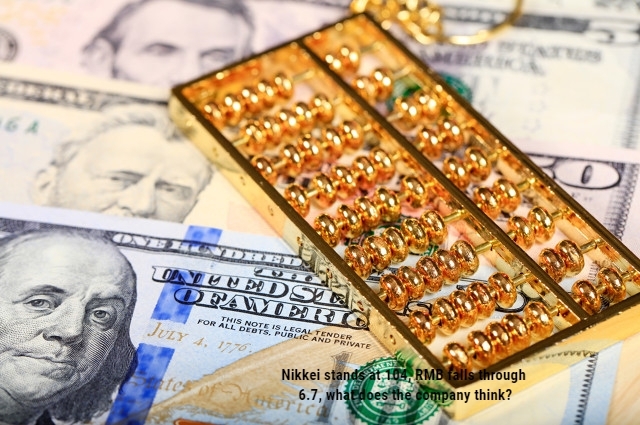Nikkei stands at 104, RMB falls through 6.7, what does the company think?

On May 9, Nikkei lifted 104 price level. On the same day, the RMB mid-price depreciated by 567 points. As of 17:15 CST, the Nikkei index stood at 104.0279. As of the close of business at 16:30, the RMB was at 6.7202 against美元 the US dollar, down 357 benchmark points from the previous trading day; as of 17:20, the US dollar was at 6.7690 against the onshore RMB, a difference of nearly 500 points between the two places.
Near the link, what factors promote RMB continuous low? How long can the strong dollar last? What are the hazards to the company in dealing with the fluctuating foreign exchange market and how should it practice the core concept of "neutral hedging" in its activities?
RMB falls through 6.7 price level
Because of the constant new crown epidemic in many parts of China, risky mentality has been somewhat reduced, in addition to the slowing rhythm of international net capital inflows into the stock and bond markets, RMB has moved all the way down from the 6.3 range before April to the 6.7 perimeter at this stage. Because the price ratio of RMB to USD and offshore accounts is relatively large, manipulators indicate that the offshore market has accumulated certain short positions. However, there has been some acceleration in the resumption of work and production in Shanghai and other places recently, which has the hope of boosting market confidence.
On May 9, the General Administration of Customs of China released information showing that in terms of U.S. dollars, imports and exports increased by 3.9% year-on-year in April (down 0.9% YoY), compared to 14.7% year-on-year in March and a 16.4% growth rate in January-February. Imports and exports were about the same compared to the same period, which prompted the surplus to remain at a low level of $51.12 billion.
The information from the General Administration of Customs data also shows that in RMB terms, imports and exports increased by 10.9% year-on-year and imports improved by 5% in January-April, with a surplus of RMB 135.483 billion; in 2021, China's imports and exports increased by 21.2% year-on-year and imports increased by 21.5% year-on-year, with a surplus of $4.36 trillion.
In the first quarter of 2022, a very large part of the factor for the long-term maintenance of rates depends on the fact that China's imports and exports are still relatively strong as of January-March. Nomura Securities China president economist Lu Ting previously indicated to news reporters that in March, the year-on-year increase in imports and exports measured in U.S. dollars slowed to 14.7% from 16.4% in January-February, still higher than the market forecast (of a consensus of 12.8%), and the trade deficit in March was $47 billion, smaller than the monthly summary average of $58 billion in January-February (but still maintained at a higher quality). If the PPI index value is used to reconcile the price utility, the annual growth rate of specific imports and exports in March would be around 4.6%, about the same as in January-February.
Although the new crown epidemic continued in April, the surplus remained at a low level of $51.12 billion. For this matter, a number of traders indicated to the news reporter that the lower rates suffered a lot from the hazards of slowing net capital inflows under hot sectors and assets.
The elite team of macroeconomic science research of Goldman Sachs feels that the service trade will remain strong in the case of import and export price increase, and the trade deficit of service items will remain at the bottom. The recent State Council executive meeting emphasized that the relevant departments are effectively ensuring smooth freight logistics and smooth supply chain management across the industry chain. This means that the decline in imports and exports in April is only temporary and the surplus will then be repaired to a stable level. Goldman Sachs distinguished that the chances of large-scale capital outflows and rapid and significant currency depreciation remain low, but it does not clear that a short period of time because of the ongoing new crown epidemic and the strengthening of the dollar will burden the exchange rate of the yuan.
At this stage, the sales market generally believes that a lower RMB is a normal reflection of the industry market. As of last week, the net discharge of northbound funds in recent years was 20.39 billion RMB, but it has turned into a net inflow of funds in April.
The strength of the US dollar exceeded forecasts
The rapid rise in the Nikkei index, which is the external independent variable of the RMB exchange rate, is undoubtedly the main factor causing RMB to go lower, while the over-estimated weakness of the European and Japanese currencies has also pushed the US dollar higher.
"The actual model shows that the US dollar seems to be in an overshoot at this stage. The most important factor is the situation in Ukraine, which has led to a gloomy outlook for the European economic development market. The sales market is betting on the future with sinking self-confidence in the European zone." An equity bank financial system trader indicated to the news reporter that the current international situation is not risky, a short time Europe can not be turned over, the Nikkei over-rising trend will continue for a longer period of time, which produces work pressure on RMB.
Related articles: